Day 1 Shanghai → Dubai ★Departure Day
All day
Today is the departure day for the event. Tourists from all over the country will gather at the terminal of Shanghai Pudong International Airport at the designated time, check in under the guidance of the tour leader, and after completing the departure procedures at the designated time, they will take the designated airline to Dubai to fly to the "northern tip of the African continent" to explore the real location of "Casablanca".


Day 2 Dubai → Casablanca, the “White City”
All day
Upon arrival in Casablanca, a professional Chinese-speaking tour guide greeted us at the airport with a sign. Casablanca, the "White City," the real-life setting for "Casablanca," sits at the northern tip of the African continent. It's also Morocco's largest city, 88 kilometers northeast of the capital, Rabat. Bordering the Atlantic Ocean, it boasts evergreen trees and a pleasant climate. From the sea, the city is awash in a boundless expanse of azure sky and sea, with a swaying white line running between them. Sometimes, the Atlantic Ocean is surging, while the harbor remains calm.
We'll visit Mohammed V Square, the administrative center built during the French colonial era. The square is surrounded by government offices, including the City Hall, the Supreme Court, the Police Station, and the old Governor's Palace. The square features a fountain, numerous pigeons, and the light rail passes through it. We'll then drive to Rick's Cafe, a cafe familiar to those who've seen the movie Casablanca. We'll then have dinner and check into our hotel.


Day 3 Casablanca → Marrakech
All day
After breakfast at the hotel, we'll travel to the renowned "Red City" of Marrakech (one of Morocco's four imperial cities) to visit the Yves Saint Laurent Garden. During his lifetime, renowned fashion designer Yves Saint Laurent and his partner, Pierre Bergé, purchased this private garden in Marrakech, Morocco. The garden is permeated with the artist's beloved blue. This enchanting shade of blue can be seen everywhere, from the villa, vases, walls, and even the pool. Like a breath of cool air amidst the sweltering heat, this blue has come to be known as Majorelle Blue. The garden also boasts over 200 rare plants from around the world, including bougainvillea, cacti, yucca, water lilies, jasmine, and more.
Afterward, visit Djemaa El Fna, the "Sleepless Square." From sunrise to late at night, you'll see local snake charmers, Arabs selling spices and tea, Moroccan elders telling stories and fortunes, various street performers, and countless stalls selling food, drinks, clothing, carpets, furnishings, leather goods, and handicrafts. It's like Hong Kong's Lan Kwai Fong or Shanghai's Xintiandi. This square gives Marrakech its endless vitality. Then, check in to your hotel and enjoy dinner there.


Day 4 Marrakech → "World Heritage" Ait Ben Haddou → Ouarzazate
All day
After breakfast at the hotel, depart for Ait Ben Haddou, Morocco's most famous ancient city and a UNESCO World Heritage site in the desert. Crossing the Atlas Pass, approximately 2,260 meters above sea level, the ancient city stands proudly atop a golden hill, offering panoramic views. Beyond the city walls, a precious shallow stream waters the surrounding greenery, while within, a staggered interplay of traditional Moroccan square-pillar towers creates a breathtaking spectacle. This ancient city in southern Morocco, once a crucial gateway, is remarkably well-preserved, earning it UNESCO World Heritage status in 1987. It is a truly beautiful ancient village. Built with Moroccan terracotta mud bricks, the city offers a glimpse into the vibrant red charm of Morocco. Over twenty international films have featured this city as a backdrop, including classics like "Lawrence of Arabia" and "Ghost Warrior." China-TravelNote offers a special lunch experience at Ait Ben Haddou, where you can admire the unique scenery of the ancient city before your very eyes!
Then, we'll arrive at the desert oasis city of Ouarzazate. This is Morocco's film location and production center. "Operation Red Sea" was filmed here.
Overnight stay at your hotel in Ouarzazate.


Day 5 Ouarzazate → Merzouga (Magical Sahara Desert)
All day
After breakfast, we'll drive to Merzouga, the gateway to the magical Sahara Desert. We'll first arrive in Erfoud, where we'll transfer to a 4x4 jeep and enter the desert. (Please bring a scarf, sunscreen, and sunglasses.) Here, you can witness breathtaking sunsets (weather permitting).
Finally, we'll arrive at Merzouga, the famous gateway to the Sahara Desert. The Sahara here is renowned for its diverse sand dunes, which change color with the changing light, showcasing stunning hues like gold and pink. The stunning scenery at sunrise and sunset creates a unique Moroccan desert landscape, a dream destination for countless people. Here, you'll see Africa's tallest red sand dunes, a filming location for the film "Lawrence of Arabia."
After resting in the hotel, you can hike to the edge of the desert to enjoy the wonderful sunset and the endless starry night sky.

Day 6 Merzouga → Fez, the Lost City
All day
Today we're kicking off a special event!!! A complimentary camel desert tour (tourists who prefer not to wake up early can rest at the hotel). Early in the morning, tourists will depart from the hotel, board camels, and head to the Merzouga region's sand dunes to watch the sunrise and capture the Sahara's most beautiful moment. Against the reddish Sahara, shimmering in the soft morning light, a caravan of camels slowly approaches, seemingly telling a long story.
Then return to the hotel for breakfast. Today will be a long drive, passing through the small town of Ifrane in the central Atlas Mountains of Morocco.
Finally, we'll travel to Fez, one of Morocco's four ancient imperial cities. Named one of the world's 10 most romantic cities by the renowned American magazine Traveler, this 9th-century Islamic capital feels like a step back in time, when donkeys were still the primary means of transportation. We'll then check into our Fez hotel.


Day 7 Fez full day activities
All day
After breakfast, we will be led by a guide to visit the old city of Fez, this medieval old city was listed as a World Cultural Heritage by UNESCO in 1981.
The old city of Fez is also known as the world's largest pedestrian street! In this largest extant Islamic city, we'll visit Attarine, Bou Inania Medersas (Quranic School), and the nearly thousand-year-old leather dyeing workshop. Morocco's leather industry is renowned and a popular tourist attraction. Fez also boasts many attractions, including the Nejjarine Spring (exterior), the Mausoleum of Idriss (Moulay Idriss Zaouia) (exterior), the world's largest university, Qarqouiyyin University (exterior), and the famous Bab Boujloud Blue Gate (also known as the Bab Zerow Gate. As the saying goes: If you haven't entered Fez through the Boujloud Blue Gate, you haven't been to Fez!).
Narrow, winding alleys, crowded bazaars, the call to prayer from mosques, and the pungent smell of leather factories present a profound challenge to the senses of sight, hearing, and taste. World-renowned handicraft workshops produce copper plates, carpets, and dyeing. Blue mosaics can be seen everywhere in the city, including in buildings, interiors, and shops displaying mosaic artworks.
After lunch, we specially arranged a [local home visit] to chat with the locals, taste authentic Moroccan-style afternoon tea, and experience the local people's afternoon time.
Fez's medina boasts over 9,000 streets and alleys, and you can also shop for souvenirs like leather, stained glass, and bronzeware in the old town, though bargaining is required (and please bargain like crazy). After dinner, we'll spend the night at the hotel in Fez.
Note: There are many attractions in the ancient city of Fez, and the order of the tour will be arranged according to the on-site situation!


Day 8 Fez → Chefchaouen
All day
Today will be a long drive, after breakfast we will head to Chefchaouen, the Blue Dream.
En route, we'll first visit our newly discovered site, Volubilis, a partially excavated Roman city known as the "Palace of the Pharaohs," inscribed on the World Heritage List in 1997. The city boasts a well-preserved triumphal arch and the white stone columns of its theater. Even the city's streets, residential buildings, oil mills, public baths, and marketplace are still clearly visible.
As you leisurely stroll through the town, stepping on the irregularly shaped cobblestones, a fairytale world unfolds before your eyes. As you ascend the steps through the arched earthen gates of the street, vast expanses of blue begin to come into view, a hazy, dreamy atmosphere pervading the landscape. It's said that the town was originally painted blue to repel mosquitoes. Later, people spontaneously painted doors, steps, staircases, window sills, flower stands, mailboxes, and almost every surface within sight. Blue has become a part of life here. The pure, fresh air and seemingly perpetually blue sky complement the sprawling Arab city, creating a natural blue canvas.
We've specially prepared two traditional Moroccan costumes for you to wear while taking some portraits in the charming town of Chefchaouen. Wear them yourself and feel like a Moroccan! (Since Moroccans may be camera-shy, we've included this feature.)
After dinner, we checked into a local B&B to rest.
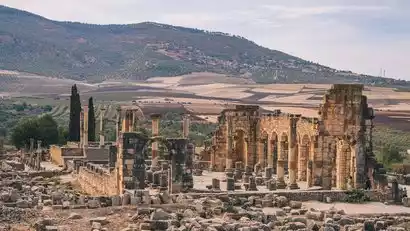
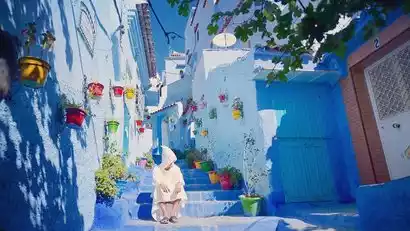
Day 9 Chefchaouen → Tangier, the Strait of Gibraltar
All day
This morning we have half a day of free time. We can get up early, as Chefchaouen is less crowded in the morning. We can stroll through the old town and observe the local culture: elderly women sweeping the streets, merchants holding up their shops, and the residents rushing about early in the morning.
After lunch, we'll travel to Tangier, home to the North African fortress known as the "Strait of Gibraltar." We'll visit the Tangier Lighthouse, located at the northern tip of Africa. Located where the Atlantic and Mediterranean meet, the Strait of Gibraltar lies before us. We'll then visit the African Cave, known locally as the "Hercules Cave." The cave's entrance resembles a map of Africa, even including the island of Madagascar. It's said to have been formed naturally by waves crashing against the rocks over thousands of years.
Then, at the Atlantic Ocean, facing the endless Atlantic Ocean, we waited quietly. Dinner was served with Spanish seafood paella.
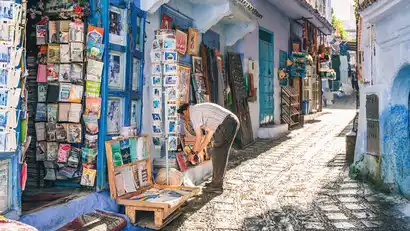
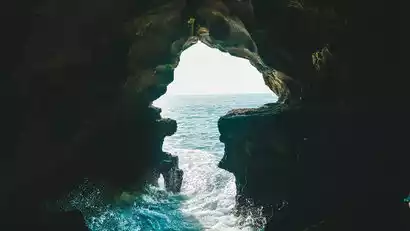
Day 10 Tangier → Asilah → Rabat → Casablanca
All day
After breakfast, we'll drive from Tangier along the Atlantic coast to Asilah, known as the "Graffiti Town." The murals on the old city walls are a unique sight. Artists from various countries have created works in diverse styles and themes. Asilah, with its predominantly white houses and Mediterranean aesthetic, is a true art mecca! The narrow but immaculate alleys of the medina are filled with beautiful murals and vibrant blocks of color, making a stroll through them feel like walking through a painting. Within the old city of Asilah, a prominent bastion overhangs the beach, creating a natural balcony. The waves crash against the rocks, rolling in in waves and creating a thunderous sound. Grab your camera and capture the murals, the front doors, and the people and stories you encounter—all of these are truly unexpected encounters.
We enjoyed lunch at a Rabat restaurant overlooking the Atlantic Ocean. Afterward, the tourists headed to the Kasbah of the Oudayas, a small town nestled on the cliffs of the Atlantic Ocean and the filming location for Mission: Impossible 5. This area, known as Rabat's Blue and White Town, offers a chance to experience the vast beauty of the Atlantic Ocean.
After arriving in Casablanca, check in to the hotel and rest.
Note: The murals in the "Graffiti Town" Asilah may be updated every year, based on the on-site patterns.
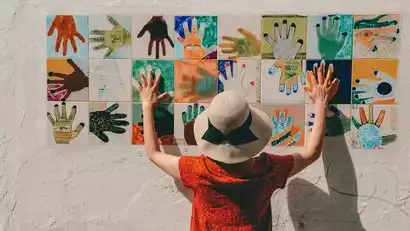
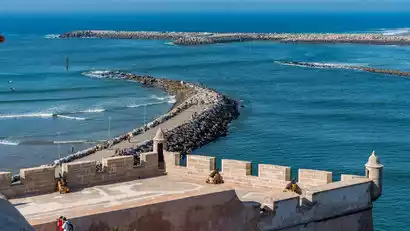
Day 11 Casablanca → Dubai
All day
After breakfast, we'll visit the Hassan II Mosque, the third largest mosque in the Islamic world. One-third of its area is built on the sea, featuring a retractable roof and 25 automatic doors made of titanium alloy to resist seawater corrosion. The marble floors are heated year-round, making it one of the most modern mosques in the world. Afterwards, we'll transfer to the airport for our connecting flight back to Shanghai.
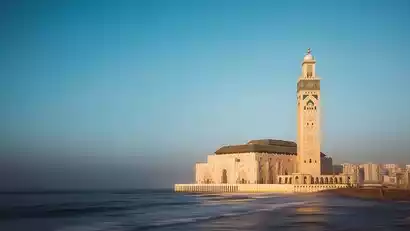
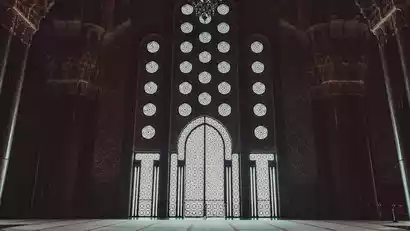
Day 12 Dubai → Shanghai ★ Disbandment Day
All day
We then arrived in Shanghai, ending our enjoyable trip to Morocco. Remember to submit your travel notes and homework after you get home!








